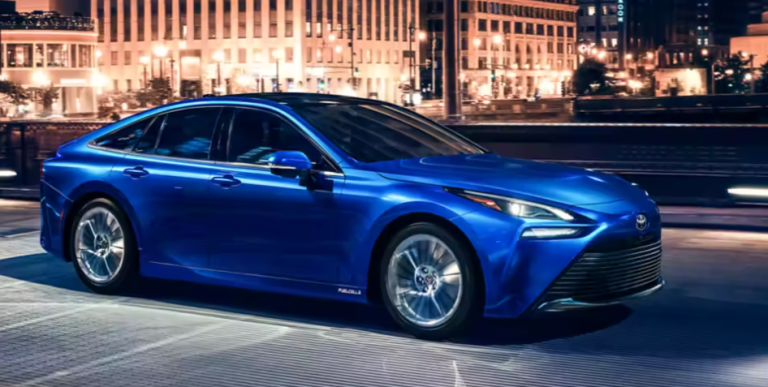Introduction
When most automakers went all in on battery electric vehicles (BEVs), Toyota went against the trend. Not with a suspicious eye, but with a tactical view.
The Japanese giant, known for engineering consistency over trend-chasing, has quietly built what could be the world’s most scalable hydrogen vehicle program. Its flagship model, the Toyota Mirai, is already on the road. And while critics question the viability of hydrogen cars, Toyota is doing what few others are willing to: testing hydrogen fuel cell tech at scale, in real-world conditions.
Table of Contents
Let’s explore how this clean tech works and why Toyota is positioning hydrogen as a serious alternative to conventional and electric cars.
Hydrogen Toyota Car: The Innovation Leading Us to a Zero-Emission Future
Although Toyota is not the first car manufacturer that embraced the idea of clean energy, they are definitely helping to shape it. Whereas the whole industry is going toward electric vehicles with batteries, Toyota predictably is betting on hydrogen as a more viable solution. The result is cars that spew out only water vapor behind them and are recharged more quickly than most of us refuel our cars.
So, let us dig deeper into exploring the science that drives this innovation.
What Drives a Hydrogen-Powered Toyota?
A fuel cell system that produces electricity from hydrogen gas is at the heart of every hydrogen-powered Toyota automobile. This is a clean and optimized process, yielding only water vapor as the car’s emission.
Toyota’s hydrogen cars, unlike those that burn fuel, have a fuel cell stack in which hydrogen combines with air oxygen to produce electricity. This is then used to power the car’s motor—a calm, smooth ride with no carbon emissions.
Key Components of Toyota’s Fuel Cell System:
- Fuel Cell Stack: The heart of the system, where hydrogen and oxygen combine to produce electricity.
- High-Pressure Hydrogen Tanks: Built to withstand extreme conditions, these tanks store hydrogen at around 700 bar, enabling long-range driving.
- Lithium-Ion Battery: Stores excess energy generated during driving, especially through regenerative braking.
- Electric Motor: Uses the electricity from the fuel cell and battery to move the car — delivering instant torque with no tailpipe emissions.
Toyota’s fuel cell technology is the product of decades of research, offering a practical clean-energy solution that feels familiar in use but groundbreaking in its impact.
Inside Toyota Mirai: Features and Goal
In creating the Toyota Mirai, the firm had their eye on one thing: to prove that a clean ride with hydrogen can be no less desirable than any other form of transport. Rather than compelling carmakers and buyers to sacrifice something, Toyota set out to build a car that was as practical, comfortable, and speedy as it was sustainable.
That goal shows in every detail—from its whisper-quiet drive to its impressive range and refined, tech-rich cabin. The second-generation Mirai takes the original further in its dynamic properties and design, placing it confidently between high-end electric and hybrid sedans.
As reported in a review by Exchange & Mart, “The second-generation version of Toyota’s Mirai is a model the brand wants you to choose on its own merits, not just because it’s a hydrogen fuel cell car.”
Toyota Mirai Features
| Range | Up to 402 miles on a full tank of hydrogen. |
| Powertrain | 182-horsepower motor with rear-wheel drive. |
| Fuel Cell System | Compact, efficient stack with improved durability. |
| Infotainment | 12.3” touchscreen, JBL® premium sound, digital gauges. |
| Safety | Toyota Safety Sense™ 3.0 with adaptive cruise, lane tracing, and collision prevention. |
| Refueling Time | Just 5 minutes at hydrogen stations. |
| Incentives | Includes complimentary hydrogen fuel at select U.S. locations. |
Beyond the Mirai: Toyota’s Bigger Hydrogen Strategy
Toyota is not creating a single hydrogen model; instead, it is creating a whole hydrogen ecosystem encompassing everything from passenger cars to heavy-duty transport.
Toyota’s Future Plans:
- A Toyota hydrogen SUV is in the works, expanding the lineup beyond sedans.
- Production of commercial hydrogen trucks and buses is under development with partners such as Hino.
- Toyota is investing in hydrogen refueling stations, especially in Japan, California, and parts of Europe.
- Research into solid-state hydrogen storage and new fuel cell materials is ongoing to improve affordability and adoption.
Toyota is positioning hydrogen as a complementary technology to battery EVs — not a replacement, but a key player in reaching carbon neutrality across different vehicle categories.
FAQs
Q1: What is the Toyota hydrogen car price?
The Toyota Mirai starts at around $52,000 MSRP, but incentives and offers can significantly lower the cost, making it more accessible in certain regions.
Q2: Is there a Toyota hydrogen SUV?
Yes, Toyota is working on developing a hydrogen-powered SUV to expand its hydrogen vehicle lineup.
Q3: What are the benefits of hydrogen cars over EVs?
Fast refueling, longer driving range, and better performance in winter make the hydrogen vehicle suitable for long trips and high-mileage users.
Q4: Can I buy a Toyota hydrogen car now?
Yes. But the Mirai is only offered in California, Japan, and some parts of Europe since the car relies on hydrogen refueling stations.
Conclusion
Toyota’s hydrogen lineup signals a quiet but powerful shift — one that could redefine the energy narrative in the auto industry.
It is not only about making cars that use alternative fuels; it is about cultivating a fresh notion of a cleaner mobility world with vision and preparedness of the required infrastructure. Of course, there are some issues, such as the refueling and consumers’ perceptions, but Toyota’s serious commitment to hydrogen means it is not just a ‘spin-off’ project but a part of the company’s core strategy for sustainable mobility.
So, what’s your take? Do you see hydrogen cars becoming part of our daily lives soon?
Let us know in the comments; we would love to hear your perspective.






